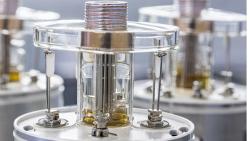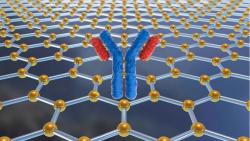
OR WAIT null SECS
- About Us
- Advertise
- Editorial Information
- Contact Us
- Do Not Sell My Personal Information
- Privacy Policy
- Terms and Conditions
© 2024 MJH Life Sciences™ and BioPharm International. All rights reserved.
THE FEASIBILITY OF TANGENTIAL FLOW FILTRATION FOR CELL LYSATE CLARIFICATION
Is it realistic to believe that tangential flow filtration (TFF), commonly used for concentration, desalting, buffer exchange, and protein fractionation, is now a viable alternative to centrifugation for cell harvest and cell lysate clarification? A new generation of membranes expands the possibilities for TFF as an economical, efficient, high-yielding process substitute, according to this case study?s author.
BioPharm Enewsletter Case Study
THE FEASIBILITY OF TANGENTIAL FLOW FILTRATION FOR CELL LYSATE CLARIFICATION
INTRODUCTION
Tangential flow filtration (TFF) is an efficient and unavoidable downstream processing (DSP) method for the clarification and purification of biologics. Membrane filtration is a solid – liquid separation technique that has been widely used in the biotech industry for many years. Depending on membrane porosity, it can be classified as a microfiltration or ultrafiltration process. Microfiltration membranes have pore sizes typically between 0.1 µm and 10 µm. Ultrafiltration membranes have much smaller pore sizes and are classified based on cutoff, which is based on their ability to retain the protein with a known molecular weight (i.e., 1 KD to 1000 KD). A rule of thumb is to select the three- to five-times smaller membrane cutoff than the molecular weight of the protein to be retained. TFF is commonly used for concentration, desalting, buffer exchange, and fractionation of proteins. Until recent years there were limited applications of TFF in cell harvest and cell lysate clarification. This case study describes the possible use of TFF as an alternative to centrifugation for cell harvest and cell lysate process.
Centrifuges are commonly used for cell lysate clarification or for the cell harvest purposes because of their ease of use at small scale and faster processing time. However, the story changes quite dramatically when it comes to scale-up because of the complex relationship between the lab-scale or bench-top centrifuge to the large-scale industrial centrifuge. The same is applicable when the centrifuge needs to be scaled down for validation or process optimization purposes. On the other hand, TFF can be easily scaled up or scaled down by keeping the channel length and channel height constant. This becomes very important for current good manufacturing practices (cGMP) contract manufacturing companies like QSV Biologics, where technology transfer and process development is very important.
The disadvantages with TFF membranes are that they foul rapidly, resulting in low flux and throughput for cell lysate processes. This can result in a system with a huge membrane area and increased cleaning burdens, especially when reusability is a requirement, making TFF a very costly unit operation compared to centrifugation. So the question is, can we use TFF for an application such as cell lysate clarification?
An argument for the possible usage of TFF for applications like cell lysate clarification becomes stronger with the new generation of membranes. These membranes, which have an ability to handle high back pressure, high ?P, and can be operated at high transmembrane pressure (TMP), resolve some of the issues and provide an efficient process with high throughput. The advantage of using TFF at this initial stage is to simultaneously achieve clarification and concentration very early in downstream processing (DSP). By concentrating the protein of interest, TFF promotes the reduction of pump size, buffer volumes, storage vessel sizes, etc. for subsequent downstream unit operations. If the next unit operation is chromatography, assuming the matrix has a high binding capacity, using TFF before the column can reduce processing time, column size, and matrix volume, which can result in significant cost savings. In addition, incorporatingTFF will also ensure an increase in column lifetime and column performance.
Another typical observation is that TFF requires higher volumes of buffers for cell lysate washing compared to centrifugation, but this depends on the rejection coefficient of the membrane for the product of interest and the impurities. Rejection coefficient can be calculated by analyzing the feed, retentate, and permeate streams. One solution to high buffer usage is a membrane with low rejection for the protein of interest and high rejection for the impurities, when impurities need to be retained. Another solution is to use a cascade TFF unit operation. Cascade TFF unit operation can lower buffer requirements because permeate of the following unit operation is a feed to the former TFF unit, assuming that the protein is retained at the second unit of cascade. The following case study will explain the purification process of recombinant proteins producedin inclusion bodies (IB).
CASE STUDY
A process flow diagram for IB purification is shown in Figure 1. Escherichia coli cells containing IB were retained using a Millipore Pellicon 2, 0.22 µm and collected for cell lysis. Harvested E. coli cells were then lysed using a pilot-scale, high-pressure homogenizer. E. coli cell lysate containing IB was loaded on a Millipore Biomax 1000 KD to remove the small proteins and low-molecular weight impurities. IB dissolution was then performed using Biomax 1000 KD under recirculation of Guanidine chloride for three hours. The soluble protein was loaded on the same regenerated 1000KD membrane, and the protein of interest was collected in permeate, leaving cell debris and other impurities in retentate. Protein was recovered in the permeate stream at the conclusion of the process, analyzed, and compared for purity with the centrifugation process.
Bottino, Chaudhry, Sourrirajan, and others have published many research papers and articles on the impact of membrane pore size, recirculation rate, permeate pressure, and TMP on the performance of the filtration process. All of these play a significant role in reducing the fouling of the membrane. TFF can significantly affect process performance and yield, i.e., process operations with high TMP, low recirculation rate, and no permeate pressure will produce low yield and also foul rapidly. Processes operating at room temperature have high flux compared to processes at low temperature due to the change in viscosity with temperature. For high throughput processes, one should maintain a minimum crossflow rate. The membrane vendor normally provides the minimum recirculation rate.
In this case the recirculation rate was maintained at 30 L/m2/min, based on the Millipore specifications for Pellicon 2. If the minimum recirculation rate is not maintained, the membrane will start building a gel layer, which will foul the membrane very quickly and potentially choke the pores irreversibly. We observed that flux was reduced from 55 ml/min to 30 ml/min during one hour of processing time. To reduce fouling, the permeate pressure was increased and adjusted to maintain constant TMP. The selection of TMP was determined by applying different TMP and ΔP on the membrane. The ideal TMP was selected based on the initial fouling condition from the TMP vs flux graph shown in Figure 2. During the process, TMP was kept almost constant to observe the fouling pattern. As the procedure continued, flow rate further decreased to 20 ml/min. It is not uncommon to use at least five diafiltration volumes of buffer if not more. These buffer requirements for TFF can be higher than the centrifuge process when operated as a stand-alone unit operation without cascade arrangement.
Table 1 shows that increasing TMP increases the flux. However increase in flux after a certain TMP is not significant and often leads to rapid fouling. In this case a TMP of 4.5 psi is the ideal value to choose for a high-throughputprocess.
Figure 3 shows the fouling characteristics of the membrane during cell lysate and IB retention. The membrane fouls rapidly after 50 minutes of processing. This fouling is due to high solid concentration in the retentate stream, which increases further during the process. Fouling can be reduced by starting the buffer wash early or by using a cascade TFF system. (Early, based on this experiment, is after 35 minutes.) Similar results were observed for the ultrafiltration (UF) step during IB dissolution and protein recovery in permeate.
Another example of the E. coli cell lysate process is shown in Figure 4, which compares a process using several precipitations and centrifuge step with the TFF process. The TFF process appears simpler and more straight forward.
Process (A) consists of several centrifuge and precipitation steps that are replaced by TFF in process (B). For proteins with a molecular weight between 100 to 150 KD, 30 KD UF membrane may be used. It is ideal for the cascade process, providing higher retention and high yield during concentration and buffer exchange steps. The flow schematic of process (B) can fractionate the protein of interest from impurities and can concentrate it to the desired level before loading to the chromatography column for further purification. The advantage of process (B) is reduced DSP with fewer steps resulting in similar or better performance compared to process (A). The fouling is reduced due to continuous dilution of feed by dilution buffer. The majority of this dilution buffer comes from the cascade loop. It is important to run all the systems at the same permeate flow rate. The use of a two-stage cascade system is much simpler and easier to control due to fewer process complications.
Conclusion
It was evident from the above examples that TFF can be used for cell lysate processing. Effective process design may require a series of small experiments to identify the optimum processing condition, which can result in an economical process with high yield. It was concluded that further trials will yield additional improvements for TFF as an alternative to centrifuge for cell lysate clarification. Using permeate pressure and optimum TMP is key to reducing membrane fouling. The cascade TFF system may be used to reduce buffer requirements and to achieve efficient impurity clearance or protein recovery.
ACKNOWLEDGMENT
I would like to express my sincere thanks to Dr. Graeme Macaloney and Dr. Shoang Chaterjee for their assistance in the preparation of this case study.
Jignesh Padia, QSV Biologics Ltd.
RESOURCES
1. Rudolph E and Macdonald J. Tangential flow filtration systems for clarification and concentration. In: Lydersen K, D’Elia NA, Nelson KL, editors. Bioprocess Engineering, .New York: John Wiley; 1994. Chapter 4:119-158.
2. Doran PM. Bioprocess Engineering Principles: Unit Operations. London: Academic Press 1995. Chapter 10:218-252.
3. Millipore Corp. Protein concentration and diafiltration using TFF – An overview. Millipore Technical Brief TB032. Billerica MA 2003. Available at: www.millipore.com/publications.nsf/docs/tb032.
4. Rathore AS, Wang A, Menon M, Riske F, Campbell J, Goodrich E, Martin J. Optimization, scale-up, and validation issues in filtration of biopharmaceuticals, Part 1. Biopharm International 2004 August; 17(8):50-58.
5. Bottino, A, Capannelli G, Imperato A, Munari S. Effect of operating conditions on the performance of the membrane. J. Mem. Sci., 1984; 21:247-267,
6. Sourirajan S, Matsuura T, Chan K, Tinghul L. Determination of interaction forces and average pore size and pore size distribution and their effects of fouling of ultrafiltration membranes. Ind. Eng. Chem. Prod. Res. Dev., 1984; 23(1):117-124.
7. van Reis R, Zydney A. Membrane separations in biotechnology, Current Opinion in Biotechnology 2001; 12:208–211.
8. Estabrook M, Beauchemin M. Membrane separations: Range of options. Amersham Biosciences. Little Chalfont UK. Application Note.
9. Mosqueda-Jimenez DB, Narbaitz RM, Matsuura T, Chowdhury G, Pleizer G, Santerre JP. Influence of processing conditions on the properties of ultrafiltration membranes, J. Mem. Sci., 2004; 231:209-224.
10. Inverson K. Troubleshooting tangential flow filtration. Chem. Eng. Progress 2003 June; 99(6):54-56.
11. Millipore Corp. Clarification of recombinant protein using TFF as a cascade operation. Millipore Application Note AN1045EN00. Billerica MA 2004.



